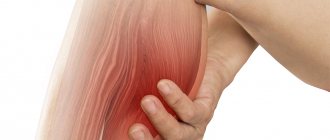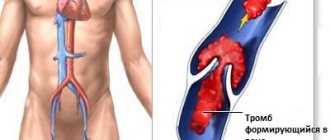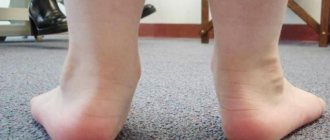Sometimes patients complain of wandering pains throughout the body of varying intensity; they can suddenly appear and disappear regardless of the time of day. There is no such disease in ICD 10; symptoms are usually provoked by various pathologies or disorders that occur in a latent or subacute stage. Often clients come to a traumatologist and ask why their arms and legs are numb, and in such cases a consultation with a neurologist is needed. But migrating muscle pain can be cured by a therapist. Diagnostics will help determine the provoking factor.
Etiology
At the first manifestation of symptoms, it is necessary to immediately determine the provoking factor. Usually myalgia accompanies acute or chronic diseases. You can independently find out why all your muscles hurt by analyzing your condition over the past few days or months.
Clinicians distinguish 7 groups of such diseases - these are the causes of muscle pain:
- fibromyalgia;
- infectious pathologies;
- myositis;
- dermatomyositis;
- muscle injuries;
- lactic acidosis;
- neuropsychic exhaustion.
Let us consider in more detail the features of the symptoms of each disease and the provoking factors of their development.
Features of the course of ARVI without fever
A respiratory viral infection is localized in the nasopharynx and after a couple of days it manifests itself as a certain discomfort. Following tickling and sneezing, copious watery discharge from the nose appears, which after a couple of days becomes mucous, sometimes mixed with blood and pus.
Medical statistics indicate that the main symptom of ARVI, with or without fever, is a runny nose. Four out of ten patients experience a sore or sore throat, and six out of ten subsequently develop a cough, which has certain characteristics associated with a cold.
Dry and superficial, it is rather a reaction to tickling. But with weak immunity, there is a possibility of it spreading to the upper respiratory tract. Having descended into the trachea and further into the bronchi, the infection can finally cause fever. Although recently there have been frequent cases of bronchitis and pneumonia occurring without a significant increase in temperature. Needless to say, when symptoms of ARVI complications appear in children, they should definitely be shown to a good pediatrician?
If the sick person also suffers from muscle pain and aches throughout the body, then his temperature will probably rise greatly, since in this case, influenza will most likely be diagnosed - the most serious of acute respiratory viral infections.
Fibromyalgia
Aching muscle pain may be a consequence of fibromyalgia, a disease of unknown origin characterized by soreness and increased fatigue in the muscles. The pathology affects women twice as often as men, accounting for 2-8% of the total number of muscle pains.
The exact causes of fibromyalgia have not been established, but scientists from the American Institute of Rheumatology identify several predisposing factors for its occurrence:
- frequent stress;
- prolonged depression;
- genetic predisposition;
- sleep disturbance;
- celiac disease.
Clinical manifestations of the disease are characterized by diffuse muscle pain, which is most pronounced in the following areas:
- under the back of the head;
- in the lower part of the neck and upper chest;
- in the elbows and knees;
- on the side of the buttocks.
The pathology has additional symptoms, the degree of manifestation of which is individual:
- chronic fatigue;
- memory impairment;
- sleep disorders;
- convulsions;
- pain in the intestines and bladder.
In most cases, pain relief helps eliminate the disease - therefore, at the first manifestations of muscle aches, you should consult a doctor.
Body aches in women - causes
Photo: envato.com
Aches in the female body without fever can be caused by diseases of the reproductive system or hormonal changes.
- Menopause and premenstrual syndrome - aching joints
- Menstrual cycle - back pain
- Algomenorrhea
- Inflammation of the internal genital organs
- Cysts
- Ovarian tumors
- Myoma
- Endometriosis
Infectious pathologies
When the muscles of the whole body ache, infectious and inflammatory processes should be assumed. Typically, such conditions are accompanied by the following symptoms:
- increased body temperature;
- chills;
- weakness and feeling of loss of strength;
- headache;
- decreased appetite;
- symptoms of the underlying disease from the respiratory, digestive or urinary systems.
The main diagnostic criterion is fever. If it is detected, the presence of an infectious pathology should be assumed. Myalgia is concentrated mainly in the back of the neck, back, shoulders and hips.
How to prevent body aches - recommendations
To avoid treating major and minor illnesses, it is better to take care of your future health and take appropriate precautions.
- Strengthen your immunity throughout the year.
- Don't forget about proper nutrition.
- Do not bring your body to a state of complete physical and emotional exhaustion.
- Spend more time outdoors.
- Don't forget about physical activity.
Important! All information in this section is presented for informational purposes only—do not use it for self-diagnosis or self-medication. To make a diagnosis and prescribe treatment, you should contact a specialized specialist.
Dermatomyositis
This disease develops gradually. Muscle pain is preceded by the following symptoms:
- feeling of weakness in the neck;
- decreased muscle strength in the forearms and thighs;
- swallowing reflex and speech disorder;
- difficulty breathing;
- inflammation in the mucous membranes;
- the appearance of a rash on the back of the hands and feet, in the joints, on the face, neck and back;
- expansion of subcutaneous capillaries.
Later, dermatomyositis manifests itself as pain throughout the body, accompanied by severe weakness and impaired self-care.
Causes of pain in the legs below the knees
What dangers can you expect? It is important to know that if the cause of leg problems is not identified in time, it will cost you in loss of health. For example, if the presence of thrombosis in the venous vessels of the lower extremities, which manifests itself precisely in the form of pain below the knee joint, is not determined, the risk of a blood clot breaking off is high. This causes the pulmonary artery to become blocked, leading to immediate death.
Remember that your health requires careful attention. And the presence of an unpleasant sensation in the legs, persistent and recurring pain, some externally visible signs indicate the need to immediately consult a doctor.
What could be the matter? Over the years, certain causes of the disease have been identified:
- As you know, human blood is filled with various types of microelements. And for the proper functioning of the body, their full composition is necessary, which is why sometimes additional medicinal reinforcement is required, for example, a complex of vitamins, which act as a daily dose of useful substances, a kind of recharge. Thus, a lack of microelements can lead to failures of certain processes. Due to a variety of diets, impaired absorption function in the gastrointestinal tract, and loss of nutrients by the body, a deficiency of calcium and magnesium, which a person needs, can occur.
- Also, the causes of pain include taking excessive amounts of drugs with a diuretic effect, drugs that reduce cholesterol concentrations, and the use of glucocorticoid hormonal substances.
- After prolonged physical activity, pain may occur as the muscles of the lower leg contract tonically.
- Myositis may occur - inflammatory reactions of the leg muscles.
- Atherosclerotic lesion with the formation of plaques in the lower leg area.
- Varicose veins of the lower extremities.
- Osteoarthritis and arthritis, when pain spreads not only to the knee joint.
- Osteoporosis.
- An infectious disease of the bone cavity called osteomyelitis. It occurs mainly in childhood.
- Those suffering from chronic alcoholism, smoking, and diabetes mellitus are susceptible to damage to nerve fibers - polyneuropathy.
- Diseases affecting the arteries of the legs.
- Rheumatic diseases.
- Compression of the soft tissues of the lower leg.
- Lymphostasis of the vessels of the lower extremities.
- Any bone, muscle or soft tissue can be subject to the formation of malignant and benign tumors.
- Paget's disease.
- Spreading metastases that cause cancer in different areas.
- Compressive processes of nerve tracts in osteochondrosis and intervertebral hernia in the lumbar part of the spinal column.
It is worth considering the most common causes of pain in the area in question in order to answer the question: why do the legs hurt below the knees ?
pain in the legs below the knees
Lactic acidosis
With this pathology, lactic acid accumulates in the muscles, which is the cause of myalgia. If during physical overload this condition is temporary, then with this disease a metabolic disorder occurs with the formation of lactate, which settles in the muscles.
The main symptoms of lactic acidosis include:
- scattered pain up to spasms;
- pain in the chest and abdomen;
- nausea and vomiting;
- rapid breathing;
- sleep disturbance;
- signs of heart failure;
- memory impairment.
In the absence of timely treatment, the patient's condition worsens, severe confusion of consciousness appears, even to the point of coma.
How to get rid of body aches if there is no fever
You can overcome an unpleasant symptom only by identifying and eliminating its cause. Therefore, even if you do not have a fever, it is important to consult a doctor. The main thing is not to self-medicate.
First aid to relieve body aches, headaches and fatigue is to:
- Take medications that you drink when you have a fever. They also help with side symptoms. However, carefully read the instructions, dosage and contraindications. Typically, such drugs contain paracetamol, ascorbic acid, caffeine and antiallergic components.
- Change your position in bed if you are not sleeping.
- Sometimes get out of bed and walk around the room. If you feel very bad, do not do this more than 2-3 times a day.
- Ask your family to provide you with peace, quiet and rest.
- Give a light massage, but without pressing hard - gently knead the muscles with light movements.
In the event that this syndrome occurs due to physical fatigue or emotional stress, it is worth reconsidering your regimen. Pay attention to the quality of your sleep, the amount of stress and rest.
Neuropsychic exhaustion
Sometimes the cause of muscle pain is nervous exhaustion. During the examination, doctors do not find any organic pathology, since the trigger is emotional instability.
Such patients experience the following symptoms:
- increased anxiety;
- irritability;
- insomnia;
- breathing problems;
- arrhythmia;
- decreased sex drive, etc.
In such a situation, a consultation with a psychotherapist is required. The doctor will create an effective treatment program.
Pain in different parts of the body
Typically, migrating pain throughout the body spreads in a certain area - the right or left limb along the forearm, hand, thigh, lower leg or foot. Synchronicity of lesions on the right and left is often noted; with such severity, a specific disease can be assumed and a preliminary diagnosis can be made. This will help prescribe a course of treatment that will give the most effective results.
You can determine what causes discomfort by location - usually the head, neck, back, stomach or limbs. Certain diseases have an attachment to topography, in which the nature of the pain is different.
In my head
If migrating pain throughout the body is accompanied by the appearance of a symptom in the head, neurological disorders should be assumed. They are caused by exogenous or internal causes:
- Pinched nerves – due to osteochondrosis or muscle spasms, spinal roots can be compressed, which provokes acute stabbing or burning pain;
- With injuries, infections or the initial stage of osteochondrosis, pressing pain in the frontal lobe may appear. In this condition, it is better to be examined immediately; sometimes the symptom is provoked by oncology;
- Often, headaches appear when wearing uncomfortable hats, caps, tight motorcycle helmets, glasses, etc. In such cases, after eliminating the provoking factor, the symptoms completely disappear.
Therapy is selected individually. If pinching is observed, massage, physical therapy, and various physiotherapeutic procedures with skeletal traction are prescribed. If an infection is present, medications are prescribed and must be taken urgently to prevent meningitis.
In muscles and joints
If wandering pain in the joints and muscles occurs, you should visit an orthopedic traumatologist, and if the doctor does not detect any damage, a consultation with a neurologist will be scheduled. The search for the cause is carried out depending on the clinical picture:
- With arthritis, pain can migrate through the joints, affecting the knees, ankles, elbows, and shoulder blades. Depending on the form of the disease, synchronicity or unilateral localization may be observed;
- Injuries or overloads of the limbs - in this case, an analogy can be drawn between pain and the provoking factor: if you often work with your hands, discomfort will be in the hands or forearms, and if you bruise your knees, they will periodically hurt;
- Infections – often intoxication is accompanied by aches and pains in the muscles and joints. In this case, pain will be noted not only in the limbs, but throughout the body;
- Diseases of the spine in the cervicothoracic or lumbosacral regions - if, due to osteochondrosis, hernias or protrusions, the nerves of nearby plexuses are pinched, the pain will spread to the limbs.
In the back and neck
Often wandering pains in the muscles throughout the body appear in the head and neck, here you should immediately assume diseases of the spine or nearby muscles:
- When a nerve is pinched, a stabbing pain usually occurs; when it is compressed, a burning pain occurs. It can be provoked by osteochondrosis, various curvatures, protrusions or hernias. Oncology is less common;
- If myositis is observed, a sharp cutting pain appears and can spread throughout the back. If you have a cold, your temperature may rise, weakness and loss of strength may occur;
- Sometimes muscle spasms develop, which cause severe pain. They usually appear in the presence of previous causes, but can greatly complicate the clinical picture of the disease.
Back and neck pain most often bother people who lead a sedentary lifestyle. When nerves are pinched, the vessels that supply the brain are often compressed. Damage to the vertebral artery, which is located in the transverse processes of the cervical vertebrae, is especially dangerous - then dizziness and headaches appear.
Treatment
To select effective therapy, it is necessary to determine the cause of pain. This will allow you to choose a medicine for a speedy recovery. The doctor will conduct an examination, prescribe laboratory and instrumental examinations, identifying the provoking factor.
The following are used as symptomatic therapy:
- analgesics in tablets (“Nise”, “Next”, “Solpadeine”);
- pain-relieving ointments (“Apizartron”, “Vipratox”, “Naftalgin”);
- local application of cold;
- massage and therapeutic exercises during remission.
For effective therapy, you can contact a rehabilitation treatment clinic, where the exact cause of myalgia will be determined. Here the patient will be under constant supervision of medical personnel and will be able to receive advice from a doctor of any profile.
Diagnostics
A general practitioner will determine the cause of body aches and weakness with or without fever. The condition can be caused by various etiological factors, so the initial examination involves an extensive range of laboratory and instrumental methods. First, the most common causes of the symptom are excluded, and if necessary, an in-depth diagnosis is carried out. The most valuable and informative are:
- Ultrasound scanning
. Complaints of body aches without an increase in temperature are characteristic of traumatic and degenerative processes, which ultrasound of the joints can help eliminate. Arthrosonography is performed to assess cartilage tissue, joint capsule and ligamentous apparatus. If you have heaviness in the legs, it is necessary to do a duplex scan of the veins to identify dilation and blood flow abnormalities. - X-ray examination
. If aches and other symptoms are localized to one part of the body, an x-ray of the affected area is taken to evaluate bone structures, cavities, or pathological formations. To exclude chronic diseases that cause discomfort, X-rays of the lungs and abdominal organs are prescribed. - Modern Imaging Techniques
. Computed tomography is more informative for studying the bony elements of the joint, their relative position and the area of attachment of the ligamentous apparatus. The method allows you to detect osteophytes, salt deposits that cause body aches. MRI is performed for a detailed study of the condition of hyaline cartilage and muscle tissue. - Invasive procedures
. If it is difficult to verify the diagnosis of body aches without fever, diagnostic arthroscopy is used to examine the joint cavity and identify changes in the early stages, when they are not visible on an x-ray. If a tumor of the blood system is suspected, the results of a puncture biopsy of the bone marrow and cytomorphological analysis of biopsy specimens are indicative. - Blood tests
. General and biochemical blood tests are intended to detect markers of an inflammatory or infectious process. If body aches occur without fever, indicators of cartilage tissue degradation (glycosaminoglycans, chondroitin sulfate), the amount of calcium and phosphorus are determined. The level of creatinine determines the condition of muscle tissue. - Specific laboratory methods
. To confirm the infectious cause of fatigue and aches felt in the body, bacteriological examination of sputum, throat swab, feces or other biological materials is indicated. The levels of antibodies to the most common pathogens are studied in the blood using ELISA. PCR is effective for searching for the genetic material of microorganisms.
In patients with aches that are felt in the body, accompanied by weakness and occurring without a rise in temperature, endocrine diseases should be excluded, so the blood is tested for levels of thyroxine, corticosteroids, and ACTH. To diagnose lesions of the peripheral nervous system, electroneurography and electromyography are performed, and a complete neurological examination is indicated. An extended immunogram allows you to exclude severe violations of the body's resistance.
If you have body aches, it is recommended to stay in bed
When should a sick person see a doctor?
A healthy body can and should overcome a mild ARVI that occurs without serious symptoms in 5–7 days. If within a week the symptoms do not go away or even worsen, we can almost certainly talk about a complication of a seemingly unimportant disease.
The patient may experience symptoms of laryngitis or pharyngitis, tonsillitis, rhinitis, signs of inflammation of the paranasal sinuses - sinusitis or sinusitis, otitis, tracheitis, bronchitis and even pneumonia. In this case, even if the temperature has not risen, you should definitely contact either your family doctor or a good ENT doctor in Moscow.
Doctors include dangerous symptoms:
- difficulty or increased breathing;
- the appearance of wheezing;
- long lasting cough;
- chest pain;
- significant increase in temperature;
- severe pain in the forehead;
- fainting state;
- confused consciousness, inability to navigate in space;
- severe vomiting.










